Education outcomes for looked after children: 2016 to 2017
Data on attainment, post-school destinations, school attendance, school exclusions and achievement of curriculum for excellence attainment levels.
Educational attainment
- ★ The attainment of looked after school leavers is steadily improving but continues to be poorer than for school leavers overall
- ★ Looked after leavers who were in foster care, and those with fewer placements had higher attainment
This section presents data on the educational attainment of the 968 young people who were looked after during the period 1 August 2016 to 31 July 2017 and who left school during 2016/17. Links to the underlying data are available in the background notes.
Age of school leavers
Chart 1: Age of all school leavers and those who were looked after, 2016/17 (1)
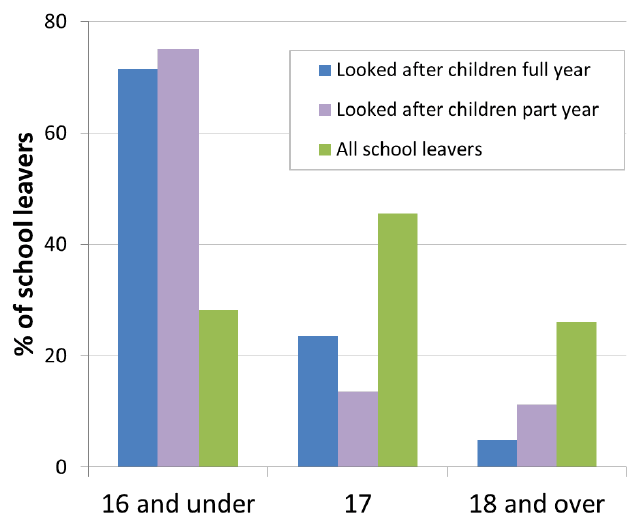
(1) The age refers to child's age the 30 June of the year they left school.
Looked after children tend to leave school at younger ages, shown in chart 1. In 2016/17 72% of children looked after for the full year and 75% of those looked after for part of the year were aged 16 and under ( i.e. they left school at the earliest point they could), compared with 28% of school leavers more generally. The proportion of leavers who were aged 16 and under has decreased since 2009/10, including among looked after leavers, but the gap between looked after leavers and other leavers remains consistent.
Highest level of qualification
Looked after children obtain lower qualification levels on average than all school leavers, which is at least partly explained by the lower school leaving age. Since 2013/14, leavers have been classified by identifying the highest Scottish Credit and Qualifications Framework ( SCQF) level at which they achieved one or more passes by the time they leave school. This includes SQA attainment at SCQF levels 3 to 7.
Illustration 3 shows the equivalent qualifications over time since Standard Grades ceased to exist in 2013/14 and Intermediate qualifications ceased to exist from August 2015 and both were replaced with the new National Qualifications. The majority of current leavers will have exclusively taken the new qualifications, but some may have taken the old qualifications. It is not the purpose of this publication to measure the impact of the new system on outcomes for looked after young people.
Illustration 2: Scottish Credit and Qualifications Framework ( SCQF) levels
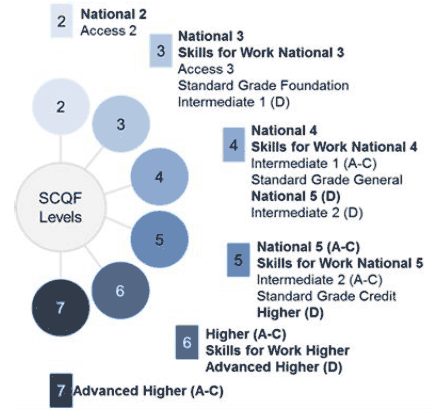
Table 1.1: Percentage of all looked after school leavers by their highest level of attainment 2016/17
| Looked after leavers – full year | Looked after leavers – part year | All school leavers | |
|---|---|---|---|
| 1 or more qualification at SCQF level 3 or better | 86 | 85 | 98 |
| 1 or more qualification at SCQF level 4 or better | 78 | 65 | 96 |
| 1 or more qualification at SCQF level 5 or better | 44 | 29 | 86 |
| 1 or more qualification at SCQF level 6 or better | 16 | 8 | 61 |
| 1 or more qualification at SCQF level 7 | 1 | 2 | 19 |
| No passes at SCQF 3 or better | 14 | 15 | 2 |
The qualification levels of young people who were looked after for the full year are higher than for young people looked after for part of the year at most attainment levels, as shown in Table 1.1. However, while looked after school leavers don't achieve qualification levels as high as school leavers more generally, educational attainment among looked after leavers has improved notably over the last seven years, narrowing the gap, seen in chart 2a and 2b.
The level of qualifications of looked after school leavers is closest to that of all school leavers at the lowest level of qualification, where 86% of school leavers looked after for the full year and 85% looked after for part of the year have at least one SCQF level 3 qualification or better, compared with 98% of all school leavers ( Table 1.1). However, the gap between looked after leavers and all school leavers increases proportionally at higher levels. The gap in attainment is greater for school leavers looked after for part of the year. This increased impact on qualification achieved is also seen for school leavers who had more placements during the year ( Table 1.3) suggesting a potential link between instability experienced in the exam year and poorer attainment.
Almost all school leavers (96%) have at least one qualification at level 4 or better. This compares with over three quarters (78%) of leavers looked after for the full year and two thirds (65%) looked after for part of the year with the same level of qualifications. At the higher levels of qualification, 61% of all leavers have at least one qualification at level 6 or better, while 16% of leavers who were looked after for the full year and 8% who were looked after for part of the year had qualifications at this level.
The continued increase in numbers of looked after school leavers achieving higher-level qualifications is one of the most notable areas of improvement in recent years. The narrowing of the gap in attainment between looked after leavers and all school leavers has not been uniform, and there have been falls in some years and at some levels. Charts 2a, 2b and 2c show the total qualifications held by looked after leavers and all leavers over time. The proportion of leavers looked after for the full year with no qualifications at SCQF 3 or higher has fallen from 23% in 2009/10 to 14% in 2016/17 ( Chart 2a). For leavers looked after for part of the year, the proportion with no qualifications has fallen from 27% to 15% over the same period ( Chart 2b). The proportion of leavers looked after for the full year with one or more qualification at level 5 or better has increased from 15% in 2009/10 to 44% in 2016/17. The number of looked after leavers with one or more qualification at level 6 has also reached its highest level at 16% ( Chart 2a).
Chart 2: Highest level of attainment of looked after leavers (full year and part year) and all school leavers, 2009/10 to 2016/17
(a) Leavers looked after for the full year
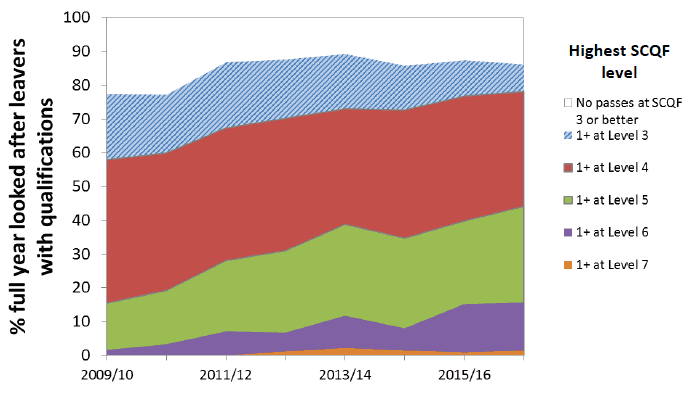
(b) Leavers looked after for the part of the year
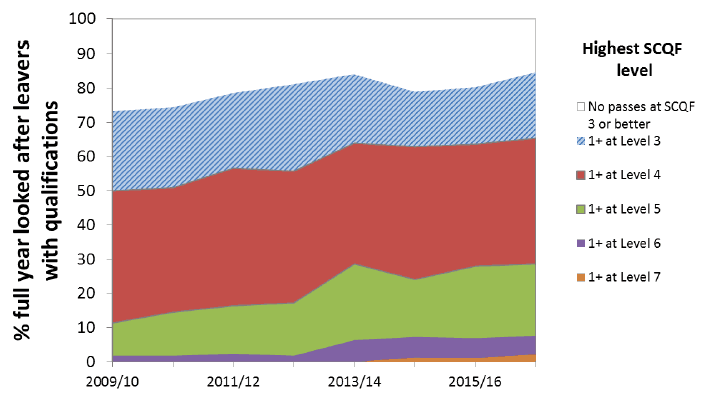
(c) All school leavers
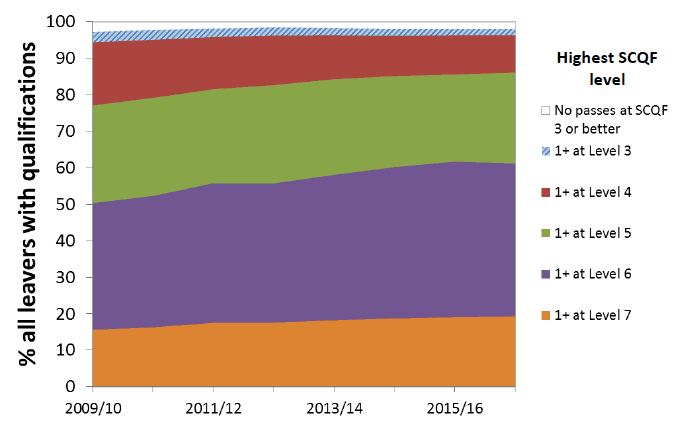
Highest level of qualification by type of accommodation
When a young person is looked after, there are various types of care setting. Placements can be at home (where a child is subject to a Supervision Requirement and continues to live in their usual place of residence), foster care, kinship care (where they are living with friends or relatives) or residential care. Table 1.2 presents the attainment level of leavers looked after for the full year by the type of placement.
Table 1.2: Highest level of attainment of school leavers looked after for the full year, by placement type, 2016/17 (1)
| Looked after leavers | ||||||
|---|---|---|---|---|---|---|
| % No passes at SCQF 3 or better | % with 1 or more qualification at SCQF | |||||
| Level 3 or better | Level 4 or better | Level 5 or better | Level 6 or better | Level 7 or better | ||
| In the community (children with one placement) | ||||||
| At home with parents | 33 | 67 | 51 | 20 | * | 0 |
| With friends or relatives | 6 | 94 | 85 | 52 | 23 | 0 |
| With foster carers provided by LA | * | * | 94 | 63 | 31 | * |
| With foster carers purchased by LA | 8 | 92 | 90 | 63 | 22 | * |
| In other community (2) | 0 | 100 | 100 | * | 0 | 0 |
| Residential Accommodation (children with one placement) | ||||||
| In local authority home | 28 | 72 | 58 | 19 | * | * |
| In voluntary home | 0 | 100 | 100 | 0 | 0 | 0 |
| In other residential (3) | 15 | 85 | 75 | 35 | 0 | 0 |
| More than one placement | 21 | 79 | 68 | 28 | * | * |
| All looked after full year | 14 | 86 | 78 | 44 | 16 | 1 |
(1) Cells containing * represent small numbers that have been suppressed to maintain confidentiality.
(2) Includes with prospective adopters.
(3) Includes in residential school, secure care accommodation or crisis care.
Educational attainment varies across the types of accommodation in which looked after children are living. Overall, more than eight in ten looked after school leavers achieved at least one qualification at SCQF level 3 or better. School leavers in foster care provided and purchased by the local authority perform better than those in other care settings (63% for both achieving at level 5 or better). School leavers looked after at home with parents had the lowest overall levels of attainment, with 20% achieving at least one qualification at level 5 or better, compared with 44% for all leavers looked after for the full year. Looked after school leavers in residential accommodation also had low levels of attainment compared with most school leavers looked after in the community.
Highest level of qualification by number of placements
Young people who are looked after may be looked after in different residences over time. Moving to a new residence or a new carer is recorded as a change in placement. Looked after school leavers who experience more placements in the year tend to have lower levels of qualifications. Table 1.3 shows that 81% of leavers looked after for the full year who had just one placement all year achieved one or more qualification at level 4 or better compared with 47% of looked after leavers who had 4 or more placements during the year.
This trend is more noticeable at higher levels of qualification. Nearly half (48%) of leavers with one placement reached level 5 or better, whereas only 19% of those with 3 placements achieved so highly. It should be noted that the number of young people with 3 or more placements is very small and care should be taken when interpreting these figures.
Table 1.3: Highest qualification achieved by school leavers (looked after for the full year) by number of placements they had in the year, 2016/17 (1)
| No passes at SCQF 3 or better | 1 or more qualification at SCQF level 3 or better | 1 or more qualification at SCQF level 4 or better | 1 or more qualification at SCQF level 5 or better | 1 or more qualification at SCQF level 6 or better | 1 or more qualification at SCQF level 7 or better | |
|---|---|---|---|---|---|---|
| 1 placement | 12 | 88 | 81 | 48 | 19 | 1 |
| 2 placements | 15 | 85 | 74 | 35 | * | * |
| 3 placements | 29 | 71 | 67 | 19 | * | 0 |
| 4 or more placements | 35 | 65 | 47 | * | 0 | 0 |
| All looked after | 14 | 86 | 78 | 44 | 16 | 1 |
(1) Cells containing * represent small numbers that have been suppressed to maintain confidentiality.
Contact
There is a problem
Thanks for your feedback